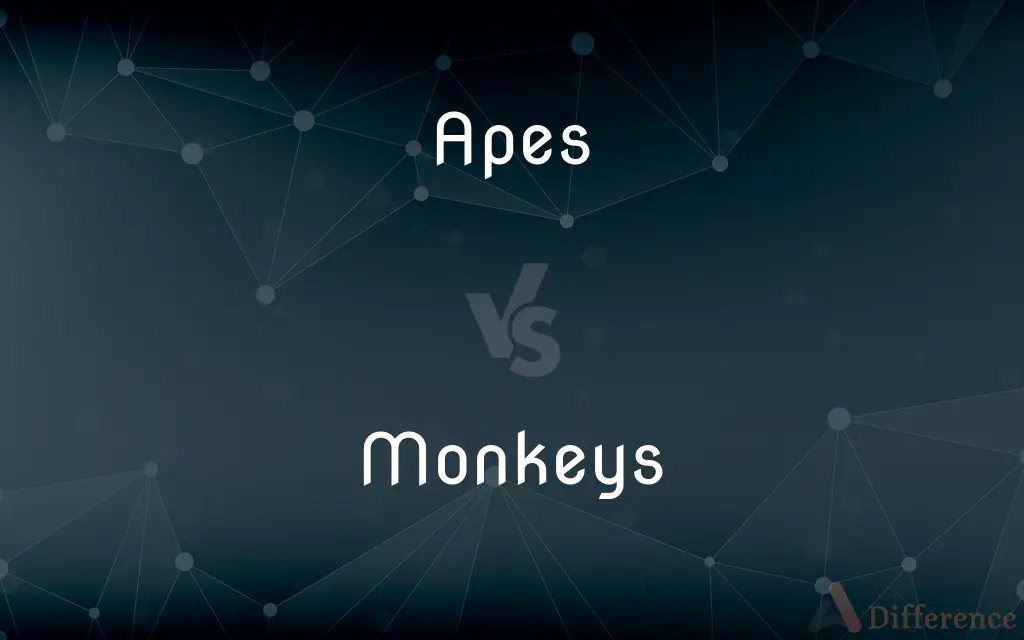Apes vs. Monkeys — What's the Difference?
By Tayyaba Rehman — Published on September 30, 2023
Apes are tailless primates with larger brains, while monkeys typically have tails and are generally smaller in size.

Difference Between Apes and Monkeys
Table of Contents
ADVERTISEMENT
Key Differences
Apes and monkeys belong to the primate family, yet they have distinct characteristics. Apes, for instance, do not have tails, which distinguishes them from most monkeys.
In terms of size, apes are generally larger than monkeys. Apes, which include gorillas, chimpanzees, and orangutans, display more advanced cognitive abilities and often exhibit complex social behaviors. Monkeys, on the other hand, vary greatly in size and behavior across species.
Apes have a more upright posture compared to monkeys. This posture, especially in species like humans and bonobos, facilitates bipedal movement. Monkeys, by contrast, often move on all fours and are adept climbers, using their tails for balance and grip in some species.
One striking difference between apes and monkeys is their brain size in relation to body size. Apes generally possess larger brains, making them capable of more sophisticated thought processes. Monkeys, while intelligent, don't display the same level of cognitive complexity as their ape counterparts.
Physiologically, apes have broader chests and shorter spines, giving them a robust build. Monkeys usually have a slender and agile body frame, which aids them in their arboreal lifestyles, swinging and jumping between trees.
ADVERTISEMENT
Comparison Chart
Tail
Lack tails.
Typically have tails.
Size
Generally larger.
Generally smaller.
Posture
More upright, facilitating bipedal movement.
Move on all fours, often arboreal climbers.
Brain Size
Larger in relation to body size.
Smaller in relation to body size.
Physiological Build
Broader chests, shorter spines.
Slender, agile body frame.
Compare with Definitions
Apes
Large-brained, tailless primates.
Gorillas and humans are both considered apes.
Monkeys
Often arboreal and agile climbers.
Monkeys use their tails to help grip tree branches.
Apes
Exhibit a broader chest and more upright posture.
Apes' physiology allows them to move bipedally.
Monkeys
Belong to the Simiiformes infraorder.
Monkeys are widespread in both Asia and the Americas.
Apes
Include species like orangutans, bonobos, and gibbons.
Apes are often studied for their remarkable intelligence.
Monkeys
Have a slender body frame aiding in their tree-dwelling lifestyle.
Monkeys are adept at navigating dense forests.
Apes
Belong to the Hominoidea superfamily.
Apes have evolved to display complex social behaviors.
Monkeys
Vary greatly in size and behavior across species.
Spider monkeys swing effortlessly between trees.
Apes
Capable of more advanced cognitive processes.
Some apes can learn sign language to communicate.
Monkeys
Any of various tailed primates of the suborder Anthropoidea, including the macaques, baboons, capuchins, and marmosets, and excluding the apes.
Apes
Any of various tailless Old World primates of the superfamily Hominoidea, including the gibbons, orangutans, gorillas, chimpanzees, and humans.
Monkeys
A nonhuman ape. Not in scientific use.
Apes
Any of various members of this superfamily bearing fur and usually living in the wild, especially orangutans, gorillas, and chimpanzees, in contrast to humans. Not in scientific use.
Monkeys
One who behaves in a way suggestive of a monkey, as a mischievous child or a mimic.
Apes
A tailed primate such as a monkey. Not in scientific use.
Monkeys
The iron block of a pile driver.
Apes
A mimic or imitator.
Monkeys
(Slang) A person who is mocked, duped, or made to appear a fool
They made a monkey out of him.
Apes
(Informal) A clumsy or boorish person.
Monkeys
Offensive Slang Used as a disparaging term for a person with dark skin.
Apes
To imitate or mimic, especially in a thoughtless or inept way.
Monkeys
To play, fiddle, trifle, or tamper with something
Who was monkeying with my phone?.
Apes
Plural of ape
Monkeys
To behave in a mischievous or apish manner
Stop monkeying around!.
Apes
Infl of ape
Monkeys
To imitate or mimic; ape.
Monkeys
Plural of monkey
Monkeys
Tail-bearing primates.
The capuchin is one of the most recognized species of monkeys.
Common Curiosities
Do monkeys always live in trees?
While many monkeys are arboreal, not all live exclusively in trees.
Do apes have tails?
No, apes are tailless, unlike most monkeys.
Which group is more closely related to humans, apes or monkeys?
Apes are more closely related to humans.
Are apes endangered?
Many ape species, such as gorillas and orangutans, are endangered due to habitat loss and poaching.
Do both apes and monkeys live in social groups?
Yes, both apes and monkeys are known to live in social groups, though the structure and size can vary.
Do all primates fall under the categories of apes or monkeys?
No, primates also include other categories like lemurs and tarsiers.
Are humans considered apes or monkeys?
Humans are classified as apes.
Are all monkeys good climbers?
Most monkeys are adept climbers, but their skills can vary by species.
What's the main difference between apes' and monkeys' locomotion?
Apes have a more upright posture facilitating bipedal movement, while monkeys often move on all fours.
Which is generally larger, apes or monkeys?
Apes are generally larger than monkeys.
Why don't apes have tails?
Evolutionarily, apes lost their tails as they adapted to different environments and modes of locomotion.
Do apes or monkeys have better cognitive abilities?
Apes generally possess more advanced cognitive abilities than monkeys.
Where can you commonly find monkeys in the wild?
Monkeys inhabit various regions, from African savannas to South American rainforests.
Which has a more varied diet, apes or monkeys?
Both apes and monkeys have varied diets, but it can differ by species and habitat.
Can both apes and monkeys be found in zoos?
Yes, many zoos house both apes and monkeys for conservation and educational purposes.
Share Your Discovery

Previous Comparison
Recklessness vs. Negligence
Next Comparison
Meeting vs. DialogueAuthor Spotlight
Written by
Tayyaba RehmanTayyaba Rehman is a distinguished writer, currently serving as a primary contributor to askdifference.com. As a researcher in semantics and etymology, Tayyaba's passion for the complexity of languages and their distinctions has found a perfect home on the platform. Tayyaba delves into the intricacies of language, distinguishing between commonly confused words and phrases, thereby providing clarity for readers worldwide.













































